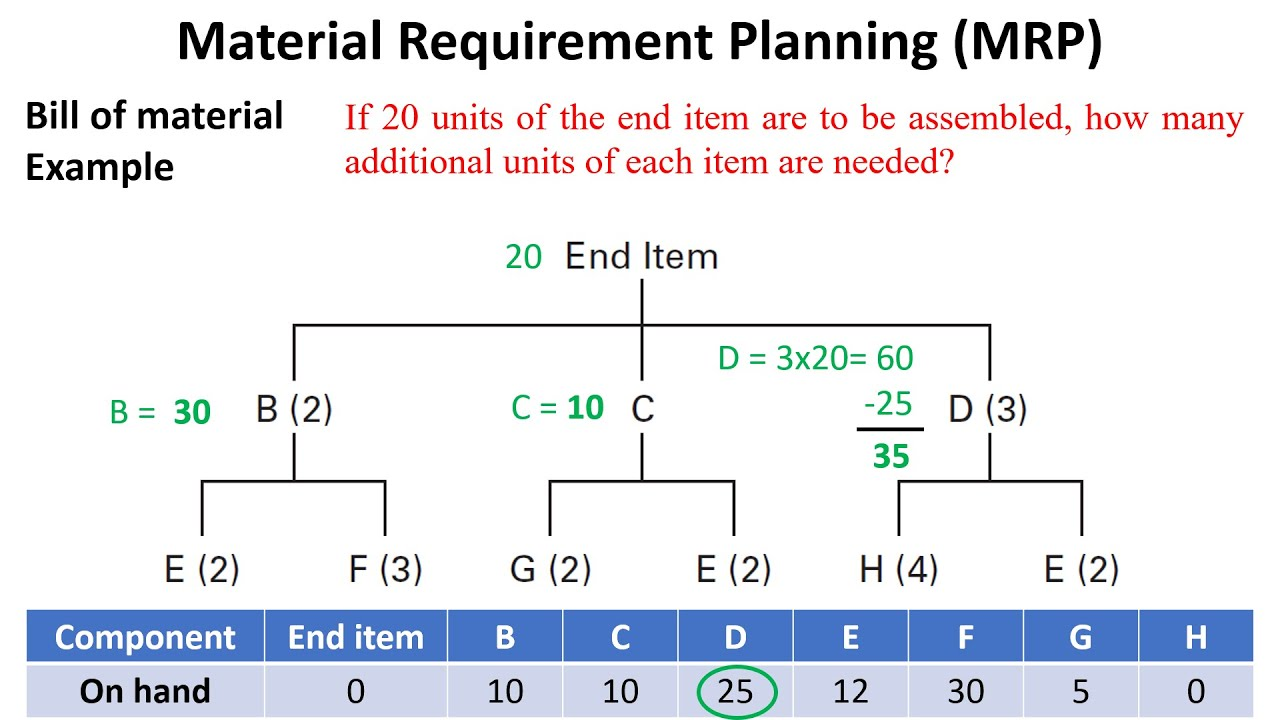Material Requirement Planning (MRP)
Material Requirements Planning (MRP) is a computer-based inventory management and production planning system designed primarily for dependent demand items – components, subassemblies, and raw materials whose need derives directly from the plan for parent items (usually end products specified in the MPS). It calculates how many parts are needed and when they must be ordered or produced to meet the Master Production Schedule.
Core Concept: MRP answers three key questions:
- What components/materials are needed? (Derived from BOM)
- How many are needed? (Derived from MPS quantities and BOM ratios)
- When are they needed? (Calculated by offsetting requirement dates by lead times)
Objectives of MRP:
- Ensure Material Availability: Have the correct components and raw materials available exactly when needed for production, preventing shortages and delays.
- Minimize Inventory Levels: Procure or produce parts only as required ("right quantity, right time"), reducing investment in raw material and Work-In-Progress (WIP) inventory.
- Improve Planning & Scheduling: Provide accurate information for production scheduling, capacity planning, and purchasing activities.
MRP System Components (Inputs):
- Master Production Schedule (MPS): Provides the demand for end items – stating what needs to be built and when. This is the primary driver.
- Bill of Materials (BOM) File: Defines the product structure. Shows all the components (parts, subassemblies) required to make one unit of a parent item, the quantity of each, and their hierarchical relationship (levels). Often visualized as a Product Structure Tree.
-
Inventory Records File: Contains up-to-date status information for each item (end product, component, raw material), including:
- On-hand inventory quantity.
- Scheduled Receipts (existing orders due to arrive).
- Lead Time (time to procure or manufacture).
- Lot Sizing Rule (e.g., order fixed quantity, lot-for-lot).
- Safety Stock (if any).
MRP Processing Logic (The "Explosion"):
The MRP software performs calculations iteratively, level by level down the BOM:
- Gross Requirements: Determine total demand for an item in each time period (from MPS for end items, or from Planned Order Releases of parent items for components).
- Scheduled Receipts: Note quantities from existing orders due in each period.
- Projected On-Hand Inventory: Calculate expected inventory level at the end of each period (Previous On-Hand + Scheduled Receipts + Planned Order Receipts - Gross Requirements).
- Net Requirements: Identify periods where projected on-hand inventory is insufficient to meet gross requirements (Net Req = Gross Req - Available Inv [Previous On-Hand + Scheduled Receipts]). If available inventory is sufficient, Net Req = 0.
- Planned Order Receipts: Determine the quantity that needs to arrive in periods with a Net Requirement (considering lot sizing rules).
- Planned Order Releases: Determine when the order (calculated in step 5) must be placed or started by offsetting the Planned Order Receipt date backward by the item's lead time. These Planned Order Releases become Gross Requirements for components at the next lower BOM level.
Outputs of MRP:
-
Primary Outputs:
- Planned Order Releases: Schedule for placing new orders (purchase or production).
- Order Rescheduling Notices: Recommendations to expedite, defer, or cancel existing orders based on changes in MPS or inventory.
- Secondary Outputs: Exception reports (e.g., late orders), performance reports, planning reports.
 MRP Tree Diagram / Time Phased Product Structure (Visual Aid): Helps visualize the BOM structure and the lead-time offsets needed to calculate component requirements based on the end-item schedule.
MRP Tree Diagram / Time Phased Product Structure (Visual Aid): Helps visualize the BOM structure and the lead-time offsets needed to calculate component requirements based on the end-item schedule.
Gross vs. Net MRP: Gross MRP simply explodes the MPS demand without considering inventory. Net MRP (standard practice) accounts for on-hand inventory and scheduled receipts to calculate net needs, thus minimizing inventory.
- Indian Example: Bajaj Auto uses MRP extensively for motorcycle production. The MPS dictates how many Pulsar NS200 bikes are needed each week. The BOM for the NS200 lists hundreds of components (engine parts, frame elements, electricals, tires). The Inventory Records track current stock and lead times for each component. The MRP system calculates precisely when Bajaj needs to issue purchase orders for tires or release internal production orders for specific engine subassemblies to ensure they all converge on the assembly line exactly when needed to build the bikes scheduled in the MPS, minimizing component inventory.
MRP is a powerful tool for managing dependent demand inventory in manufacturing environments, leading to reduced inventory, fewer shortages, and improved scheduling efficiency.

No Comments